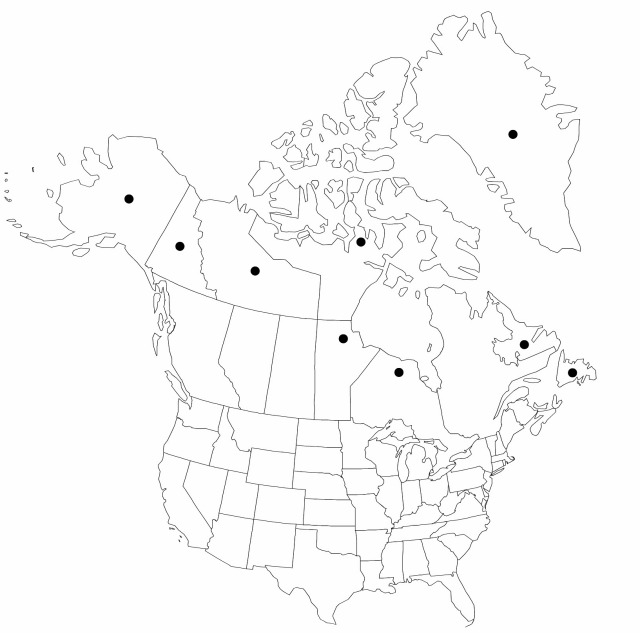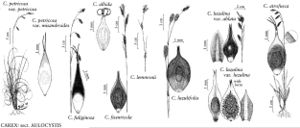Carex atrofusca
Beschr. Riedgräs. 1: 106, plate Y, fig. 82. 1801.
Plants loosely cespitose; rhizomes short, slender. Culms to 30 (–60) cm. Leaves: blades 2–4 mm wide. Inflorescences 2–6 (–8) cm; proximal internode 10–40 mm; peduncle of proximal spikes exserted to 4 cm; proximal bracts with blade 5–22 mm, sheath cylindric, 5–28 mm, mouth usually tinged with dark purple, 0.9–1.4 mm wide Spikes 2–5; lateral spikes usually pistillate, inclined or pendent, 8–19 × 4–7 mm; terminal spike staminate or gynecandrous, erect or inclined, 6–15 × 2–5 mm. Pistillate scales black with pale midvein, ovate or oblongovate, 3–4.8 × 0.9–1.6 mm, margins narrow and scarious, apex acute to obtuse, papillose at least on midvein. Staminate scales black with pale midvein, oblong-obovate, 3–5 × 1.2–1.8 mm, margins scarious, apex acute or obtuse. Anthers 1.9–2.6 mm. Perigynia ascending, pale-brown proximally, black distally, indistinctly veined, ovate, 3–4.8 (–5.5) × 0.9–1.6 mm, papillose at least on margins; beak distinct, 0.3–0.5 mm. Achenes ellipsoid, 1.4–1.6 × 0.7–0.9 mm.
Phenology: Fruiting summer.
Habitat: Sedge meadows, moist shores
Elevation: 10–300 m
Distribution

Greenland, Man., Nfld. and Labr., N.W.T., Nunavut, Ont., Que., Yukon, Alaska, Eurasia
Discussion
Carex atrofusca is the only species in sect. Aulocytsis with papillose perigynia, suggesting that it is perhaps misplaced.
Selected References
None.
Lower Taxa
"shortened" is not a number."wide" is not a number.
